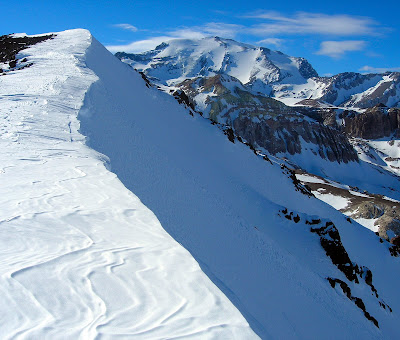We shall not cease from exploration
And the end of all our exploring
Will be to arrive where we started
And know the place for the first time.
T.S. Eliot, "Little Gidding"
And the end of all our exploring
Will be to arrive where we started
And know the place for the first time.
T.S. Eliot, "Little Gidding"
I went for a stroll. It wasn't a planned stroll but it was all that was available. I expected a bit more. Snow, that is. Portillo was and is still reporting an obscene amount of snow, something like sixteen feet. Even if the Juncal Valley is a little lower in elevation than Portillo, sixteen feet of snow would have been plenty for a nice tour and climb. But it was the first time up the Rio Aconcagua this year and I really didn't know what to expect. And it was a good thing, too, 'cause there ain't sixteen feet of snow up there.
The Juncal Valley is a massive chunk of earth whose northerly mouth becomes the Rio Aconcagua valley itself and whose southerly head constitutes the most heavily glaciated section of the Central Andes. The immensity of it is staggering and a day's tour reveals only the tip of its beauty. The Chile From Within website provides historic and geologic information about the valley. The creator of the website is apparently a descendant of the family that owns the upper reaches of the valley and that has now secured it as the Parque Andino Juncal.
The day was gray, the light was flat, and the air was warm. The coffee shakes heading out of Los Andes.
The bottom of the valley is littered with the remnants of an abandoned mining operation.
Unreal City,
Under the brown fog of a winter dawn
T.S. Eliot "The Waste Land"
Under the brown fog of a winter dawn
T.S. Eliot "The Waste Land"
From there it's onward and upward. It was clear the day wasn't going to be much more than a tour up the main dirt road. The coverage was thin to nonexistent. Nearly every gully had spit out its upper holdings of snow from the previous storm. Still, no matter the activity, time alone in the Andes is time well spent. I don't normally carry music with me but I was glad that I did. With the volume turned up just enough to hear both the music and the river, it provided an ambient soundtrack to an ambient day.
If you can get over the
I saw something high on a slope so I decided to leave the road and climb up to check it out. More remains of something that once was but is no more, slowly returning back to a previous state. Broken concrete, bent steel, cables that vanish in the snow and rocks. Unfinished projects.
what branches grow out of this stony rubbish?
The last of what appears to be a memorial of some sort, to who knows what or who knows who.
I hunkered with the dogs in the tunnel for a bit for no real reason other than I could and there was no real reason to do anything else. It was quiet and cold.
Winter kept us warm, covering
Earth in forgetful snow, feeding
A little life with dried tubers.
Earth in forgetful snow, feeding
A little life with dried tubers.
Back down to the river for lunch on a steel bridge.
If there were only water amongst the rock
Dead mountain mouth of carious teeth that cannot spit
Here one can neither stand nor lie nor sit
There is not even silence in the mountains
But dry sterile thunder without rain
Dead mountain mouth of carious teeth that cannot spit
Here one can neither stand nor lie nor sit
There is not even silence in the mountains
But dry sterile thunder without rain
And finally back down to the Comunidad "Los Campos Cano Gallegos" where you will always find a warm room and a friendly face.
Back to the highway and the running of the rigs. Back to the noise of life. Back to the famous Portillo curvas.
And finally back to a world of color.
If I could help one drifter on this long, relentless road,
I’d warn him of its random ways and the dangers it might hold,
But I know I ain't no prophet and I ain't no prophet's son—
Just a long time comin’ and I'll be a long time gone.
Bob Dylan "Long Time Gone"
I’d warn him of its random ways and the dangers it might hold,
But I know I ain't no prophet and I ain't no prophet's son—
Just a long time comin’ and I'll be a long time gone.
Bob Dylan "Long Time Gone"









































